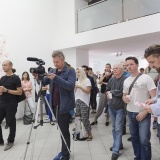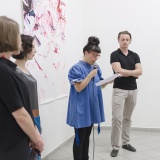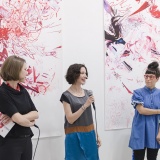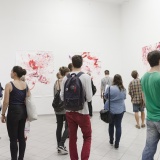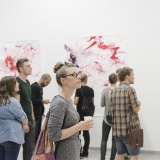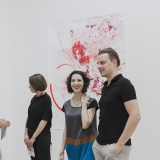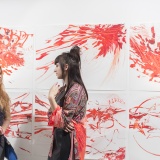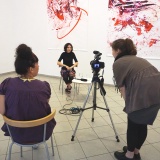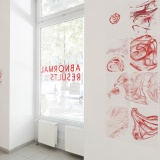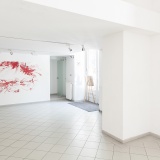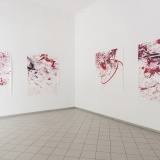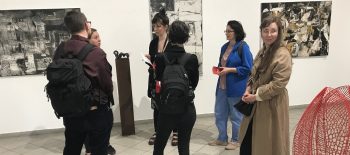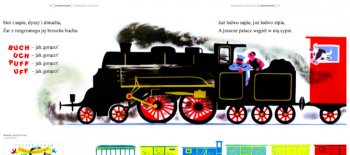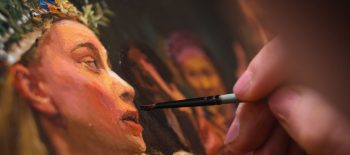16 września (środa), godz. 19.00 — 15 października 2015 r. (czwartek)
1061 Budapest, Andrássy út. 32
Wystawę otworzy Zsikla Mónika historyk sztuki
Maess ur. 1982 w Warszawie. Absolwentka warszawskiej ASP, stypendystka Escola Superior de Artes e Design w Porto.
Jej rysunki ukazały się w FUKT Magazine 8/9 oraz na promującej go wystawie w warszawskim Centrum Sztuki Sztuki Współczesnej (2010).
W 2012 roku Maess otrzymała nominację do Grand Prix FID Prize w Paryżu oraz znalazła się na liście finalistów Strabag International Art Award w Wiedniu (2013).
Wystawiała między innymi w Plumba Contemporary Art, Porto, Portugalia (2006), Residencia Corazón, La Plata, Buenos Aires, Argentyna (2008), Museo di Santa Cecilia w Rzymie (2010),Galerii Program w Warszawie (2011), Muzeum Współczesnym Wrocław (2013) Galerii Miejskiej Arsenał (2013) i w Drawing Center Nowym Jorku (2014)
ABNORMAL RESULTS
Eksplozje intensywnej czerwieni natychmiast przykuwają naszą uwagę i wywołują niepokój. Przywodzą na myśl krew, obawę przed bólem, chorobą i śmiercią.
Choć w liczącym kilkadziesiąt rysunków i wciąż rozrastającym się cyklu „Było sobie życie ” autorstwa Maess na pierwszy rzut oka nic nie jest dopowiedziane i dosłowne, wskazówki, które naprowadzają widza na ten trop kryją się również w tytułach prac: „Krwotok”, „Krwioplucie” czy „Krzywe przeżycia”. Jeden z rysunków nosi tytuł „Kroją mi się piękne sprawy”, co jest oczywistym nawiązaniem do twórczości wybitnej polskiej rzeźbiarki Aliny Szapocznikow.
Kiedy na przełomie lat sześćdziesiątych i siedemdziesiątych w twórczości Szapocznikow pojawił się motyw choroby nowotworowej, artystka nie mogła obserwować komórek i tkanek pod mikroskopem elektronowym, nie mogła skorzystać z Internetu, w którym dziś z łatwością znajdziemy takie zdjęcia. Jej uwaga skupiała się na tym, co widoczne na powierzchni wyniszczonego przez chorobę ciała.
Dzięki zaawansowanej technologii i stosunkowo łatwemu dostępowi do informacji Maess może eksplorować jego tajemnicze, fascynujące wnętrze.
Od dwóch lat zapoznaje się z dokumentacją medyczną i wykorzystuje zdobytą wiedzę w złożonym procesie twórczym: korzystając ze zdjęć, baz danych, programów do tworzenia modeli 3D, farb akwarelowych, długopisów i markerów przekształca ją i każe jej funkcjonować w świecie sztuki według nowych, narzuconych przez siebie zasad.
Mimo tych wyraźnych odautorskich wskazówek jej intrygujące prace pozwalają widzowi na swobodną interpretację, a dzięki bogactwu detali wciąż możemy odkrywać je na nowo.
Dynamiczne, splątane linie i plamy opowiadają o kryjących się w naszym ciele, wrogich i niepokojących, a jednak, dzięki działaniom artystki, uderzająco pięknych światach.
Beauty of decay
Polish Warsaw-based artist Maess Anand presents her newest series of drawings „Abnormal results” in Platan Gallery in Budapest. We asked Maess to share her views on applied techniques, inspirations and experiences behind these works.
Patrycja Rup: Exhibition in Platan Gallery includes numerous drawings, some of them were already presented at “The Drawers” group exhibition in Warsaw, when did you start creating this series? What was the main goal of this project?
Maess Anand: Since 2012, I have been fascinated by the complexity of the technology implemented for data visualizations, which inspired me to create drawings derived from data sets called „United Networks”. The subject of cancer evolved slowly from these works. However, it was personal events, that triggered my reflection on the disease and re-invoked a curiosity in biology. I felt that the vast scientific data available from graphs and technical drawings, did little to express the fears of pain, disease and death. In 2013, “Abnormal Results” emerged. Studying the research that has been made in attempts to cure cancer and developments in this field, I have become captivated by the interwoven processes of both normal and pathological growth and the perplexity of the unknown mechanisms behind them. The intention of this project is to capture all these thoughts, which are overwhelming from the informative point of view itself, and dwell into the emotional burden in a context of vulnerability of a human being.
“Abnormal results” is based on the wide medical research, what sources you used in the project?
In all, three sources of data are combined to create the works. The least transformed source are pictures from histopathology reports with varied views of normal and cancer cells. The second type are spiderweb like clusters generated in data visualization software illustrating, for example, incidence of cancer or cancer related conversations on Twitter. Separately, simple two dimensional graphs, such cancer survival rates, are fed into 3D software as used in architectural visualizations , to which I then add my own dimensional parameter to render shapes and forms. The dimensional parameter that I manipulate is a metaphor for the “unknown” control mechanism within the realm of “known” factors behind the cancerous processes.
In your works you use different strategies and technics, from marker sketches to watercolour, why do you find creating a drawing after generating high-tech digital picture important?
„Abnormal results” is about mortality, fragility, beauty of decay. To have only rendered an image digitally, would have left the work with an impression of detachment and impersonality. It was essential to further engage with the works by drawing in order to retain the fragility of a human hand touch and with all imperfections.
“Abnormal results” attracts attention with its vivid red colors, what does it mean to you?
Red as a colour is hard to ignore. It is used for warning sign (red flag), a symbol of passion, and as well massacre and hemorrhage. For this reason, I use red to make topographical marks for the viewer to “navigate” across my works.
Lately you started widening the range of technics and applying other colors like purple and blue, how do you see the evolution of the presented works from the typographic „J’ai Tres Envie De Toi” to the latest drawings?
In my earlier works, „Excessive” , made in 2009, I used acronym JTEDT as a sort of wax seal that symbolized carnal desire. In „Abnormal Results”, there are remnants of JTEDT, however the typography exists but as passion transformed into the Schopenhauerian „Will-to-live” , desire to survive, despite the circumstances. In the words of Kandinsky; „Color is the keyboard, the eyes are the harmonies, the soul is the piano with many strings. The artist is the hand that plays, touching one key or another, to cause vibrations in the soul.” In my recent works I expand repertoire of colours which are consistent with my subjective reports of synesthetes. Synesthesia can manifest in many forms, in my case I see the words letters and sounds in a certain colour.
In your works (and in interviews) you refer often to Polish artist Alina Szapocznikow, how her sculptures influenced your works?
The works of Szapocznikow did not influence me in the process of creating the „Abnormal Results” cycle. Szapocznikow’s sculptures and my works are the very dissimilar take on the same topic. Alina Szapocznikow focused her attention on what was visible on the surface of a body, her body, racked with disease. What I draw is cancer seen from a cellular level, using wide complex data sets and networks. My works are very much influenced by latest technological breakthroughs. As a person living in XXI century I have a plethora of resources at my fingertips; reading all sorts of discussion boards, medical publications, blogs of patients, clinical trials promises, studying survival rate calculators, and hence a very different approach. Such images were not available to Szapocznikow nearly 50 years ago. Her works are very important to me because it provides a reflection on how our contemporaneity shapes the way an artist conceives and executes ideas and how an artist’ life and work in an intertwined Zeitgeist.










